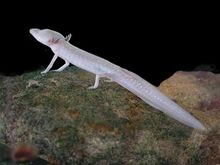Texas blind salamander
| Texas blind salamander | |
|---|---|

| |
| Scientific classification | |
| Domain: | Eukaryota |
| Kingdom: | Animalia |
| Phylum: | Chordata |
| Class: | Amphibia |
| Order: | Urodela |
| Family: | Plethodontidae |
| Genus: | Eurycea |
| Species: | E. rathbuni
|
| Binomial name | |
| Eurycea rathbuni (
Stejneger , 1896) | |
| Synonyms[4] | |
| |
The Texas blind salamander (Eurycea rathbuni) is a rare and endangered
Description
The species has a broad, flat snout and head, and vestigial eyes beneath that are covered by skin. Like other
Distribution and habitat
Specimens have been collected at seven localities in the Purgatory Creek system and along the San Marcos Fault near San Marcos, Texas. Adults and immature larvae are well-adapted for living in underground streams in caves, and many probably inhabit deep recesses that are not accessible to collectors. Specimens have been taken in deep pools with minimal current and nearly constant 21–22 °C (70–72 °F) temperatures. The first specimens of this species were collected in 1895 from a newly constructed well that drew water from 58 metres (190 ft) below the surface.[7]
Breeding and courtship

The time of breeding is poorly documented.
The female then rubs her snout more rapidly over the base of the tail. The male may lead the female forward and repeat the same cycle while slowly vibrating the anterior third of the tail. The male eventually bends the body laterally and moves the tail laterally at a right angle to the body while the female continues rubbing the base of the tail. The male then leads the female forward, bends his body into an S-shaped pattern, and deposits a spermatophore on the substrate. He next leads the female forward with the tail extended laterally until she picks up the spermatophore cap with her cloacal lips. The spermatophore consists of a crescent-shaped white sperm cap over a clear, gelatinous base that is about four times longer than it is wide.[12] The species is found to have a delayed reproductive maturity and low reproductive output, with females found to produce 5, small egg clutches on average per year.[13]
Conservation
Populations of Texas blind salamander are sensitive to groundwater pollution.[1] They are additionally vulnerable to depletion of groundwater resources,[1] which occurs over time when withdrawals for commercial or domestic purposes exceed aquifer recharge through percolation, etc. Long-term groundwater availability is being monitored using the flow of the San Marcos River as a surrogate measure.[14]: 9
As of 2004, the population trend of the Texas blind salamander is stable, according to the IUCN.[1] A five-year review published in 2021 identified all downlisting criteria as being "partially complete", but warned that current groundwater withdrawal limits do not take into account the likelihood of increasing frequency and intensity of droughts due to climate change.[15]
See also
References
- ^ a b c d IUCN SSC Amphibian Specialist Group. (2023). "Eurycea rathbuni". IUCN Red List of Threatened Species. 2023: e.T39262A118975720.
- ^ "Texas blind salamander (Eurycea rathbuni)". Environmental Conservation Online System. U.S. Fish & Wildlife Service. Retrieved 27 April 2023.
- ^ 32 FR 4001
- . Retrieved 5 February 2021.
- JSTOR 1444041.
- ^ Vieira, Warren A et al. “Characterizing the regenerative capacity and growth patterns of the Texas blind salamander (Eurycea rathbuni).” Developmental dynamics : an official publication of the American Association of Anatomists vol. 250,6 (2021): 880-895. doi:10.1002/dvdy.245
- ^ a b Hillis, D.M.; Chamberlain, D.A.; Wilcox, T.P. & Chippindale, P.T. (2001). "A new species of subterranean blind salamander (Plethodontidae: Hemidactyliini: Eurycea: Typhlomolge) from Austin, Texas, and a systematic revision of central Texas paedomorphic salamanders". Herpetologica. 57: 266–280.
- ^ "Texas Blind Salamander". Herps of Texas.
- JSTOR 1467045.
- JSTOR 1447075.
- ^ a b Froese, Rainer; Pauly, Daniel (eds.) (2011). "Satan eurystomus" in FishBase. December 2011 version.
- JSTOR 3672107.
- ^ Glass Campbell, L., Anderson, K. A., & Marcec-Greaves, R. (2022). Topical application of hormone gonadotropin-releasing hormone (GnRH-A) stimulates reproduction in the endangered Texas blind salamander (Eurycea rathbuni). Conservation Science and Practice, 4( 3), e609. https://doi.org/10.1111/csp2.609
- ^ "Recovery Plan Amendments for Eleven Southwest Species" (PDF). Albuquerque, New Mexico: U.S. Fish and Wildlife Service Southwest Region. 6 December 2019. Retrieved 27 April 2023.
- ^ "Texas Blind Salamander (Typhlomolge rathbuni) 5-Year Review: Summary and Evaluation" (PDF). Austin, Texas: U.S. Fish and Wildlife Service, Austin Ecological Services Field Office. 26 April 2021. Retrieved 27 April 2023.


